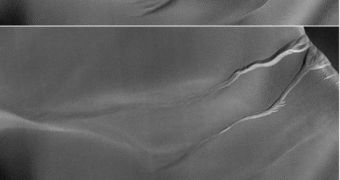According to a team of investigators, it would appear that the gully-like formations that various missions to the Red Planet identified on its surface were most likely produced by frozen carbon dioxide, and not by water as previously stipulated.
The team that made the discoveries says that not all of the gullies can be explained through these mechanisms, and that some of the features still remain mysterious to this day.
Over the recent years, studies have demonstrated without a doubt that water once flowed on Mars, and that some rivers, or at least groundwater, was liquid only several hundred thousand years ago.
For the new study, the research team looked at how sand dune gullies changed over the past 15 years, at some 7 locations throughout the southern areas of Mars.
A complete analysis of all datasets available of these locations demonstrated that each of the gullies analyzed changed as the season unfolded, with the largest differences identified during the winter.
Experts in Mars sciences say that this was to be expected under the new theory, given that winter is when carbon dioxide builds up on the planet. This season cannot be associated with more runoff being produced by melting water, given the low temperatures at those locations.
“Gullies that look like this on Earth are caused by flowing water, but Mars is a different planet with its own mysteries,” explains the lead author of the new investigation, expert Serina Diniega.
“The timing we see points to carbon dioxide, and if the mechanism is linked to carbon dioxide frost at these dune gullies, the same could be true for other gullies on Mars,” adds the scientist.
Diniega holds an appointment at the NASA Jet Propulsion Laboratory (JPL), in Pasadena, California.
She explains that the gullies she and a University of Arizona graduate student analyzed had a length of between 165 feet (50.3 meters) and more than 2 miles (3.2 kilometers).
One of the most interesting conclusions of the new investigation was little changes appeared to occur at the gullies during the Martian spring, summer and autumn, which is when water would act most intensely.
Readings of these areas were collected by two NASA spacecrafts, the Mars Global Surveyor and the Mars Reconnaissance Orbiter (MRO). The latter satellite functions to this day.
“One possibility is that a pile of carbon dioxide frost accumulating on a dune gets thick enough to avalanche down and drag other material with it,” Diniega says of why the gullies change during the winter.
Full details of the new study appear in the November issue of the esteemed scientific journal Geology, Space reports.

 14 DAY TRIAL //
14 DAY TRIAL //